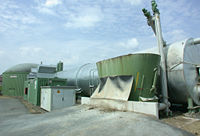
Photo from wikipedia
The goal of this study is to assess the technical feasibility of remediating siloxane contaminants in biogas via a photochemical process. Specifically, we studied in the laboratory a process that… Click to show full abstract
The goal of this study is to assess the technical feasibility of remediating siloxane contaminants in biogas via a photochemical process. Specifically, we studied in the laboratory a process that involves the use of an ultraviolet (UV) photodecomposition reactor (PhoR) to convert siloxane trace impurities, commonly found in biogas produced in water treatment plants and landfills, into silica particulates. These can then be effectively removed from the reactor effluent with the use of a downstream filter. High siloxane conversions were obtained, which demonstrates the effectiveness of the technique. The proposed technology is presently being field-tested in a California landfill.
Journal Title: Industrial & Engineering Chemistry Research
Year Published: 2018
Link to full text (if available)
Share on Social Media: Sign Up to like & get
recommendations!